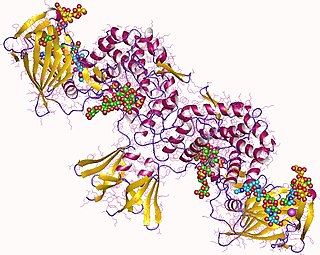
Glucuronic acid is a uronic acid that was first isolated from urine. It is found in many gums such as gum arabic, xanthan, and kombucha tea and is important for the metabolism of microorganisms, plants and animals.

Uridine 5'-diphospho-glucuronosyltransferase is a microsomal glycosyltransferase that catalyzes the transfer of the glucuronic acid component of UDP-glucuronic acid to a small hydrophobic molecule. This is a glucuronidation reaction.

UGT2B7 (UDP-Glucuronosyltransferase-2B7) is a phase II metabolism isoenzyme found to be active in the liver, kidneys, epithelial cells of the lower gastrointestinal tract and also has been reported in the brain. In humans, UDP-Glucuronosyltransferase-2B7 is encoded by the UGT2B7 gene.

Heparosan-N-sulfate-glucuronate 5-epimerase is an enzyme with systematic name poly( -beta-D-glucuronosyl- -N-sulfo-alpha-D-glucosaminyl) glucurono-5-epimerase. This enzyme catalyses the following chemical reaction
For beta-glucuronidase, see Beta-glucuronidase
In enzymology, a flavone 7-O-beta-glucosyltransferase is an enzyme that catalyzes the chemical reaction

In enzymology, a galactosylgalactosylxylosylprotein 3-beta-glucuronosyltransferase is an enzyme that catalyzes the chemical reaction
In enzymology, a luteolin-7-O-diglucuronide 4'-O-glucuronosyltransferase is an enzyme that catalyzes the chemical reaction
In enzymology, a luteolin 7-O-glucuronosyltransferase is an enzyme that catalyzes the chemical reaction
In enzymology, a N-acetylgalactosaminyl-proteoglycan 3-beta-glucuronosyltransferase is an enzyme that catalyzes the chemical reaction
In enzymology, a N-acetylglucosaminyl-proteoglycan 4-beta-glucuronosyltransferase is an enzyme that catalyzes the chemical reaction

UDP-glucuronosyltransferase 1-6 is an enzyme that in humans is encoded by the UGT1A6 gene.

UDP glucuronosyltransferase 2 family, polypeptide B4, also known as UGT2B4, is an enzyme that in humans is encoded by the UGT2B4 gene.

UDP-glucuronosyltransferase 2B17 is an enzyme that in humans is encoded by the UGT2B17 gene.
Baicalein 7-O-glucuronosyltransferase is an enzyme with systematic name UDP-D-glucuronate:5,6,7-trihydroxyflavone 7-O-glucuronosyltransferase . This enzyme catalyses the following chemical reaction
Cyanidin-3-O-glucoside 2-O-glucuronosyltransferase is an enzyme with systematic name UDP-D-glucuronate:cyanidin-3-O-beta-D-glucoside 2-O-beta-D-glucuronosyltransferase. This enzyme catalyses the following chemical reaction
Soyasapogenol glucuronosyltransferase is an enzyme with systematic name UDP-D-glucuronate:soyasapogenol 3-O-D-glucuronosyltransferase. This enzyme catalyses the following chemical reaction
D-Man-alpha-(1->3) -D-Glc-beta-(1->4) -D-Glc-alpha-1-diphosphoundecaprenol 2-beta-glucuronyltransferase is an enzyme with the systematic name UDP-glucuronate: D-Man-alpha-(1->3) -D-Glc-beta-(1->4)-D-Glc-alpha-1-diphospho-ditrans,octacis-undecaprenol beta-1,2-glucuronyltransferase. This enzyme catalyses the following chemical reaction:

Luteolin-7-O-glucuronide is a chemical compound that is classified as a flavone.

Estradiol 3-glucuronide (E2-3G), also known as 17β-estradiol 3-(β-D-glucuronide), is a naturally occurring and endogenous estrogen conjugate. It is specifically the C3 glucuronide conjugate of estradiol, the major estrogen in the body. It is formed from estradiol in the liver by UDP-glucuronosyltransferase via attachment of glucuronic acid and is eventually excreted in urine and bile. Similarly to estrogen sulfates like estrone sulfate, estrogen glucuronides have much higher water solubility than do unconjugated estrogens like estradiol.









